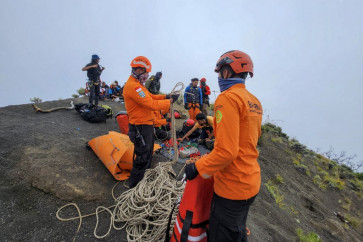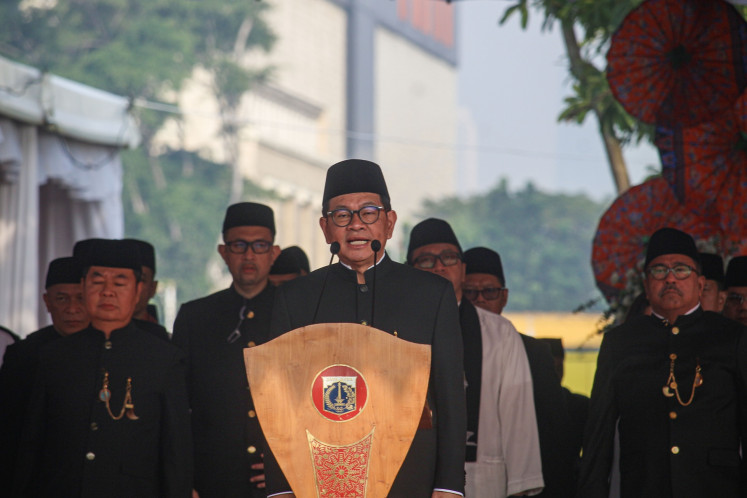Popular Reads
Top Results
Can't find what you're looking for?
View all search resultsPopular Reads
Top Results
Can't find what you're looking for?
View all search resultsSpoiled by sea & spice
Oceanic:: The sunsets off Morotai in North Maluku are glorious
Change text size
Gift Premium Articles
to Anyone

Oceanic:: The sunsets off Morotai in North Maluku are glorious.
“Ayo rame-rame ke Tidore” or “Let’s all go to Tidore” urges the video produced by Tidore’s tourism office.
While the suggestion should by all means be taken to heart, there is a touch of irony considering the tiny island is anything but rame, meaning busy.
Nestled next to its neighbor and historic rival Ternate along the west coast of the sprawling island of Halmahera in North Maluku, Tidore has a population of less than 100,000 living amid spectacular, desolate vistas over serene ocean; decaying Spanish forts; and the perfect volcanic cone of Mount Kiematubu.
If one is lucky enough to be invited to lunch at Kedato Kie, the silent, stately home of Tidore’s sultan, then there may also be a
feast of local cuisine to enjoy while being regaled with stories of the sultanate’s long history and current search for a new leader after Sultan Djafar Syah passed away in April leaving no heirs.
The spread of delicacies laid out in the spacious main hall of the palace — just adjacent to a sacred meditation room where the next sultan will be determined — included gohu, which combines raw fish with shallots and citrus juice; an asparagus-like treat termed sayur lilin (literally candle vegetable); and a local crab cooked in both sweet and spicy sauces, the crab a type that consumes coconut, giving the meat a distinctive flavor.
With tourism coming into focus for many of the regencies in far-flung North Maluku that includes the islands of Ternate, Tidore, Halmahera and Morotai, local governments are emphasizing the richness of local cultures, which includes the luscious foods on offer that afternoon in Tidore, especially considering the area’s long history of spice production.
At a recent press roundtable, North Halmahera regent Hein Namotemo said, “We are focusing on local identity with our tourism in order to support our people … but we also need innovation.”
Brochures for North Halmahera extoll the area’s pristine waters and dive spots, as well as its unique flora and fauna. During a visit to a small beach with a handful of cottages for tourists south of North Halmahera’s capital of Tobelo, children performed a traditional tide-tide dance and a small band of grinning older men played pleasing Pacific-inspired tunes on guitars, ukuleles and a bass that looked like a giant wooden box, everyone decked out in one innovation of the regency — a print in purple and tan reminiscent of batik.
Otje, the North Halmahera Culture and Tourism Agency head, pointed out a pile of bananas. “You can only find those bananas here. They are called mulut bebek because the shape is reminiscent of a duck’s mouth. Try one,” he urged.
While the bananas were delicious and the dance and music lovely, the potentially idyllic scene was marred by the decision to situate the bungalows next to a looming, concrete Pertamina edifice set right on the beach.
Tourism missteps like this could be seen at a number of spots during a whirlwind tour of the region, but were more an indication of tourist infrastructure in its early development than anything else, and were all overwhelmingly eclipsed by the unspoiled beauty of the province.
A boat ride from Tobelo past radiant green islands brings visitors to a small, scenic pier on Kakara Island, touted for its dive sites. One afternoon there was a bambu gila performance, with young men lifting and struggling with a large slab of painted bamboo while onlookers giggled. Outside the dive lodge, young coconuts were on offer with sweet, fresh palm sugar from the island.
But, the accommodations at the lodge were cramped considering the space to build, and strangely situated away from the beach and its many stunning views.
North Maluku Governor Thaib Armaiyn said in a speech during an event for Sail Morotai 2012, which aimed to support economic development in the province, “This is the entryway for the development of North Maluku in the future … our location is extremely strategic in the Asia-Pacific region.”
That development even extends to the arts, with Christine Hakim, reportedly working on a documentary on North Maluku, showing up on tiny Kolorai Island off Morotai during the occasion nattily dressed in maritime-inflected attire.
It was Tidore’s booth at Sail Morotai, amid others from all points of North Maluku’s compass, that stood out with its vibrant décor of bamboo and palm. But one particularly local innovation, toasted sago in flavors like mango and strawberry packaged for sale, will probably not be the newest oleh-oleh sensation in the country for those returning from vacation.
Ternate Sultan Mudaffar Sjah spoke about an event in Ternate that attracts tourists. “Its called Legu Gam, a pesta rakyat, we hold it every year in April,” he told The Jakarta Post.
He added that the palace in Ternate welcomes tourists. But does he reside there? “I have to live there. It’s a requirement. If I don’t they’ll kick me out,” he said with a laugh.
M. Amin Faaroek, the Tidore sultanate’s secretary and resident historian, gave visitors a tour of Tidore’s palace and told tales of past sultans and the island’s relationship with nearby Papua.
“Centuries ago sailors from Tidore departed, later returning with stories of a land filled with beautiful birds. When asked where the place was, they responded ‘papo ua’ or ‘not close’,” he said, while one example of the beauty that spurred long ago sea voyages sat on a shelf nearby — a bird of paradise, dead, stuffed and mute but still dazzling.
The breezy Tidore palace is flanked by two 17th century Spanish forts currently being renovated that offer impressive views of Halmahera and Ternate. Their stone walls, built during the advent of the spice trade, are vividly tangible reminders of the place’s peculiar contact with European powers many centuries ago.
Ternate’s sultan discussed the many Portuguese and Dutch forts and the poor shape they were in. “I spoke to the Portuguese embassy about the forts [on Ternate]. They said they were ready to help out with funds when we are ready to start renovations […] the Dutch embassy too.”
And so it seems links forged and fought so many centuries ago over the clove and other spices still
remain, albeit in altered form.
At a press conference during the Sail Morotai events, Tourism and Creative Economy Minister Mari Elka Pangestu discussed the tourism possibilities in the area, saying, “There is the history of the spice trade, at that time spices meant wealth, it was the same as gold […] The point is that stories from the area are very interesting and we should promote Morotai together with Ternate and Tidore, all those relationships […] Everyone has this image of the Spice Islands, we should take advantage of that.”
With the liberation of time, these places people once risked their lives to discover or to defend now offer more innocuous yet stunning pleasures, with people now free to shape that past — and even better, the present and the future.
— Photos By JP/Deanna Ramsay









